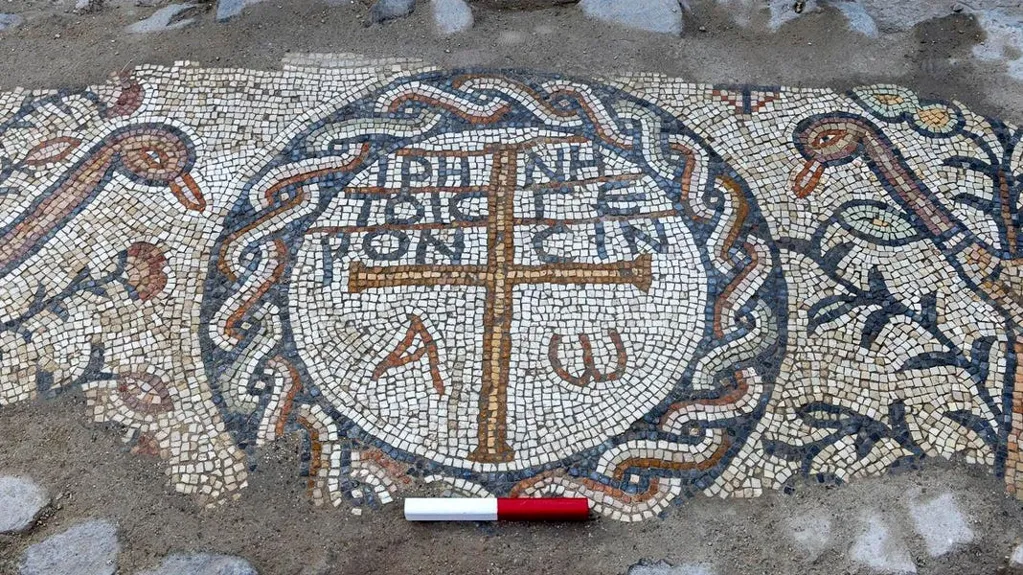A well-preserved mosaic uncovered in northern Israel could be the remnant of an elder care home dating back to the late 4th or early 5th century, archaeologists say. If so, it would be the earliest concrete evidence of such a facility found in an archaeological dig to date.
Archaeologists excavating the ancient Christian Byzantine city of Hippos, located on a hill east of the Sea of Galilee, came to that conclusion after studying part of a mosaic floor they'd uncovered at the threshold of a public building. The section contained a three-line Greek inscription reading "peace be with the elders" located on the upper half of a cross divided by its horizontal bar. The mosaic also depicts alpha and omega, the first and last letters in the Greek alphabet -- when paired, they're used as a Christian symbol. A variety of colorful motifs flank the medallion, including Egyptian geese, birds drinking from a chalice and citrus and cypress trees.
"It is testimony to how the Christian community in the Holy Land during the Byzantine period cared for the elderly, a responsibility that until then had been placed solely on the shoulders of the family," the authors of a new study on the find said in a joint statement. "This development likely reflects new Christian ways of life outside traditional family structures, such as monasticism."
The study appears in the August issue of the journal Zeitschrift für Papyrologie und Epigraphik, which publishes research related to papyrology and epigraphy from classical antiquity. While written sources suggest nursing homes became more common in the region from the Christian era onward, the researchers call their discovery "living proof."
"It may be assumed that the mosaic was placed at the entrance of a building that was in some special way open to, or perhaps dedicated to, elderly people," the study says. The medallion "placed the greeting to the 'elders' on the lips of each person entering, or addressed it to the inhabitants of the building."
During excavations in 2023 and 2024, a team from the University of Haifa's Zinman Institute of Archaeology uncovered a preserved patch of the mosaic, which was broken on all four sides and covered with construction debris containing Byzantine pottery fragments and bits of the shattered mosaic, including other inscriptions that can't be reconstructed. Beneath the floor, they found coins dating back to the late 4th or early 5th century.
The Christian symbols on the mosaic initially suggested the floor was part of a church. But the archaeologists, who have already excavated a number of churches and religious buildings at Hippos, couldn't find architectural evidence that they had discovered another one.
So they began to ponder other possibilities by considering the mosaic's inscriptions and visual style, as well as its location near the intersection of two major streets. They also turned to historical documents that referenced the moral obligation to care for the elderly and the establishment of specialized senior care facilities. The team, which also includes Gregor Staab, a University of Cologne classical philologist, looked to other ancient inscriptions as well. One, from Jerusalem, reveals that a donor couple from Byzantium established a "home for humble elderly women" in connection with a church dedicated to Mary Theotokos, a Greek title for the Virgin Mary.
Leslie Brubaker, a professor emerita of Byzantine art at the U.K.'s University of Birmingham who was not involved with the research, called the find "deeply cool." She also noted that hospitals of that era and place had sections that focused on elder care, "so you may be dealing with a section of a larger hospital."
Such hospitals were often attached to churches, added her fellow University of Birmingham Byzantine scholar Daniel Reynolds.
"The use of the cross, alpha and omega and laurel wreath is a motif usually only seen in church or monastic contexts," he said in an interview. "However, the water of life (cup with doves) motif is also something which could well fit with a healing context. We could well be looking at a urban monastery which also had space and provision for elderly care."
Until archaeologists have excavated more of the site, "I think the jury could be out on this one," he said.
The researchers behind the study agree that further exploration is warranted.
"We still have so many questions raised following this research," archaeologist Michael Eisenberg, a co-director of the Hippos project with Arleta Kowalewska," said in an interview. "Some will be tackled by colleagues who are no less excited than we are."
Hippos belonged to the Decapolis, a group of 10 cities considered centers of Greek culture in an area with a predominantly Semitic population. Hippos, a religious, social and agricultural hub during the Byzantine period, is part of Sussita National Park managed by Israel Nature and Parks Authority.
Archaeologists have excavated Hippos continuously since year 2000, finding treasure troves that include Roman basilica, theater and bathhouse; Roman-era gates; gold jewelry—a key vantage point for trade, agriculture and defense during Byzantine period.
"Our goal is to try to fill in gaps in historical narrative not only of Hippo's inhabitants—their way worshipping daily life," Eisenberg said of excavations there—"but this case illuminate whole new idea known mainly written sources about century later."
